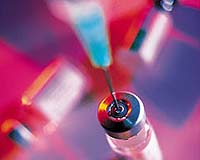| . |  |
. |
Melbourne (AFP) July 15, 2009 Australia's swine flu cases topped 10,000 Wednesday as officials in the worst-hit Asia-Pacific country reported two more deaths and warned the virus "preferred young people." Health Minister Nicola Roxon said the national tally was now 10,387, more than 10 percent of the global total confirmed by the World Health Organization with 123 people in hospital. South Australia and Queensland states reported two deaths of people with the disease, taking the national flu-linked toll to 22. A(H1N1) has not been confirmed as the cause of any of the deaths. Roxon said the number of cases would climb as the southern hemisphere winter progresses. She said the real caseload was likely much higher as mild infections were not being tested. "The numbers are expected to peak in August ... the pandemic strain of flu is becoming the predominant flu strain in Australia this winter," the minister told reporters. She said those hit hardest mostly had pre-existing medical conditions, but warned that health authorities were now worried about a growing number of serious cases in young people. "We do see that there are some people who are young and otherwise healthy who have the rapidly deteriorating disease ... it's obviously concerning," she said. Roxon said patients' average age was 19, adding that doctors and health workers had been told to watch for young people with trouble breathing because their condition could quickly become life-threatening. "We flagged early on that we were concerned that this was not the same as other flus, that it seemed to be a disease that preferred young people," she said. Another high-risk group is the impoverished Aborigines, who account for 698 cases or almost seven percent of cases even though they make up only 2.5 percent of the population. "This is not a surprise given our awareness that those particularly at risk are those with chronic diseases and that many indigenous Australians have those," Roxon said. Australia has ordered 21 million doses of a forthcoming vaccine, enough to immunise the entire population if necessary, as concern grows over the pandemic which the WHO has described as "unstoppable." Roxon said Australian pharmaceutical firm CSL would begin human trials of a swine flu vaccine next week and, if successful, it should be available in October. She also rejected a report that computer modelling had shown the virus could kill up to 10,000 in New South Wales state alone over a two-month period if the mass immunisation is not carried out. "We've seen some fairly ambitious, if not ludicrous, claims being made that it could be 10,000 or 20,000 or 30,000 in particular states," she said, adding that the death rate was not as high as initially feared. Roxon said the government's own modelling projected 6,000 deaths under a worst-case scenario but the steps being taken to contain the disease meant it would be far lower. "That's the modelling if no action was taken, of course we are taking a lot of action and we believe that can be significantly reduced," she said. According to the UN's World Health Organization (WHO), 94,512 cases of A(H1N1) influenza have been reported, causing 429 deaths. Share This Article With Planet Earth
Related Links Epidemics on Earth - Bird Flu, HIV/AIDS, Ebola
 Countries plan for mass vaccinations against swine flu
Countries plan for mass vaccinations against swine fluRome (AFP) July 14, 2009 The "unstoppable" swine flu pandemic Tuesday raised fears of millions of cases by next year and countries talked about mass vaccinations, while South America sought a united front to combat the disease. Italy predicted it may have dealt with between three and four million cases of swine flu by March 2010, the country's deputy health minister Ferruccio Fazio said Tuesday. He added that by ... read more |
|
| The content herein, unless otherwise known to be public domain, are Copyright 1995-2009 - SpaceDaily. AFP and UPI Wire Stories are copyright Agence France-Presse and United Press International. ESA Portal Reports are copyright European Space Agency. All NASA sourced material is public domain. Additional copyrights may apply in whole or part to other bona fide parties. Advertising does not imply endorsement,agreement or approval of any opinions, statements or information provided by SpaceDaily on any Web page published or hosted by SpaceDaily. Privacy Statement |